Medical expert of the article
New publications
Angioma removal
Last reviewed: 06.07.2025

All iLive content is medically reviewed or fact checked to ensure as much factual accuracy as possible.
We have strict sourcing guidelines and only link to reputable media sites, academic research institutions and, whenever possible, medically peer reviewed studies. Note that the numbers in parentheses ([1], [2], etc.) are clickable links to these studies.
If you feel that any of our content is inaccurate, out-of-date, or otherwise questionable, please select it and press Ctrl + Enter.
An angioma is a neoplasm that doctors classify as a benign tumor. This pathology is the formation of conglomerates of blood and lymphatic vessels. Mostly, this problem occurs in humans in the womb. There are cases in which the removal of angiomas is the only way to get rid of this problem.
Methods of angiomas removal
As mentioned above, in most cases the pathology considered in this article begins to develop in utero. In this case, it is recommended to radically solve the problem that has arisen before the child reaches one year of age. We are talking about surgical intervention. This approach to treatment allows preventing further growth of the pathology, as well as minimizing the possibility of their recurrence.
One of the protocols for treating angiomas is the prescription of drugs belonging to the hormonal pharmacological group. But often their use cannot completely eliminate the problem, leaving residual defects. Therefore, in most cases, the most effective way to get rid of the problem is the removal of angiomas.
Today, there are various methods for removing angiomas. In some cases, surgical treatment is carried out in stages. The main goal of such treatment is the complete removal of neoplasms, restoration of normal functioning of the vascular and lymphatic systems.
It is worth recalling the most frequently used methods that allow one to effectively rid a patient of single and group clusters of angiomas.
- Cryotherapy is the burning of pathological neoplasms using low temperatures (cold). In this case, a refrigerant such as liquid nitrogen is used. This method is effective, while preventing bleeding.
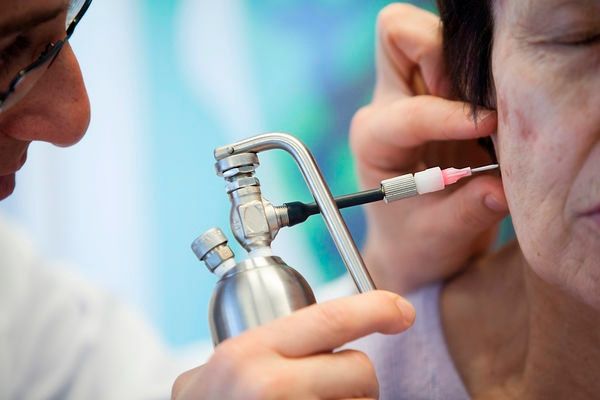
- In case of cavernous angiomas, sclerotherapy is mainly performed. The essence of the technique is in the use of special iodine salts, which allow to normalize the cross-section of certain blood vessels, which has a positive effect on blood flow. The injection is performed in cases where the angioma is located in a place difficult to access for a more extensive surgical intervention.
- Electrocoagulation is the cauterization of pathological neoplasms using electric current. This method has been used less and less recently due to its painfulness and residual effects in the form of log scars. But this method is simple and cheap.
- Laser treatment. In this case, the process of tumor removal is carried out in several stages. In this case, layer-by-layer excision of mutated tissues occurs. This process is repeated until healthy cells appear and mutated cells are completely removed. In this case, damage to healthy tissues is minimal.
- If the desired result cannot be achieved with the above methods, then doctors resort to excising the tumor with a surgical scalpel.
- The most advanced, but complex and not universally applicable methods of excision are radio- and electric knife. Innovative technology allows to easily and practically without leaving stitches to rid the patient of his problem. It is worth noting that this method requires special medical equipment and highly qualified doctor. Today, not every specialized institution can boast of such equipment. At the same time, this procedure is still quite expensive, so not every patient can afford it.
The method of angiomas removal is mainly chosen by a doctor - a dermatocosmetologist. His decision is based on the results of a visual examination of the patient and the capabilities of the clinic. In most cases, sclerotherapy or removal of the neoplasm using a laser is prescribed. These two methods are painless and highly cosmetically effective, the result is obtained over several sessions.
Surgical treatment
Much to the regret of many patients, modern medicine does not have a panacea in the form of a pill, taking which would solve all medical problems. This also applies to our disease.
The most radical and at the same time one of the most effective methods of getting rid of angioma is surgical treatment of the disease. Today, there are several methods that meet this requirement:
- This is a surgical removal, which is prescribed in case of a deeper location of the neoplasm. It allows to remove the neoplasm completely, although it is quite traumatic, causing more damage than other methods. Excision is resorted to in the event that other methods are not very effective. But modern medicine is ready to offer less traumatic methods of getting rid of vascular neoplasms.
- Using a gamma knife or cyber knife. The essence of the method is the ability of radiation supplied by a medical device to seal the blood vessels that feed the angioma. This makes it possible to cut off the supply to the neoplasm, which leads to its death.
- Another surgical treatment method is the introduction of a certain blocking substance into the supplying artery using a vascular catheter. The mechanics are similar to the previous treatment method.
Laser angioma removal
Of course, it is easier and more effective to fight any pathology during its inception and development. When angioma is detected early, the number of procedures is minimal. Sometimes one is enough for the problem to disappear. One of the most effective and innovative methods of stopping the problem is laser angioma removal.
If the case is neglected and the appearance of radial blood processes is observed, the situation becomes more complicated. In this clinical picture, excision of the central blood supply arteriole does not give the expected result. Since in this case the efferent radial capillaries will not be empty, due to the fact that they are also fed by numerous collateral connections with the tissues of the skin.
In this case, to remove the star-shaped neoplasm, doctors mainly resort to the method of laser angioma removal. In this case, the patient should be prepared to undergo a number of procedures. And the more advanced the case, the more of them there will be.
The main advantage of this treatment method:
- Minimal trauma.
- High efficiency of the result.
- The ability to minimize the extent of damage to healthy tissue.
- After the procedure, a small scar is formed, which will dissolve on its own over time.
- The procedure itself is carried out quite quickly, in a matter of minutes.
- This "operation" is not very painful, but if the patient wishes, local anesthesia can be used.
- For some time, the spot that formed at the site of the operation will differ in color, since during the procedure, melanin cells are destroyed in this area, but over time this defect disappears and pigmentation is restored.
- The number of complications and relapses is minimal.
Recently, this method has been increasingly given preference in the issue of solving the problem discussed in this article.
After any surgical intervention, each patient undergoes a rehabilitation (recovery) period. At the same time, after laser removal of angiomas, this period of time is minimal. The process of regeneration of skin cells occurs quite actively and quickly.
Initially, the cauterization site will be covered with a crust. It will fall off fairly quickly, revealing the already healed wound. Mostly, if the case is not neglected, the removal occurs in one go, but if the case is complicated, the patient may have to undergo a step-by-step removal.
Immediately after the operation, the patient receives a number of recommendations that should be followed over the next few days (from five to seven days).
- The cauterization site should be protected from getting wet.
- You should not scratch the wound.
- Do not allow the crust that has formed on the wound to come off; at some point it will come off on its own.
- Avoid prolonged exposure to sunlight.
As the practice of recent years shows, laser removal of angioma is the most effective and minimally invasive method of treatment in modern cosmetic dermatology.
But it is worth remembering that only a specialist can assess the situation and choose the most appropriate method for getting rid of the neoplasm given the clinical picture.
Removal of angioma at home
Some respondents, afraid to go to a clinic, try to get rid of the problem on their own at home. Such bad doctors should be warned - removing angioma at home is absolutely unacceptable.
Medicines for angioma
We will have to immediately disappoint those respondents who are trying to beg a doctor for some pill that will allow them to get rid of the problem, being afraid to decide on surgical intervention. But to date, a panacea for the disease in question in the form of pills or injections has not yet been found. Only if, for some reason, surgical treatment of angiomas is not allowed, then the doctor has no choice but to prescribe drugs related to the pharmacological group of hormonal drugs in the treatment protocol.
Prednisolone is usually prescribed by a specialist in such a situation. Other drugs - its analogues - may be prescribed instead. For example, medopred, prednisolone 5 mg yenafarm, prednigeksal, decortin, solu-decortin, inflanefran, novo-prednisolone, prednisolone, prednisolone acetate, sherizolon and others.
The glucocorticosteroid prednisolone is taken in a dosage that is calculated based on the patient's body weight and height. Taking this drug leads to blocking the growth of the tumor, provokes drying of the pathological vascular branching.
The starting daily dose is prescribed in the range of 20 - 30 mg. This dosage is gradually reduced. The schedule of taking and reducing the dose of the drug is prescribed by the attending physician. The drug is taken under his supervision.
For small patients, this daily dosage is calculated using the formula – 1-2 mg per kilogram of the baby’s weight. The resulting amount of the drug is divided into four to six doses.
The only contraindication for the use of this drug in the treatment protocol is increased intolerance of the body to prednisolone or one of its components.
Doctors also recommend taking a larger dose of the medication in the first half of the day and a smaller dose after lunch.
Some protocols of such treatment also include cytostatic drugs, which are designed to slow down or suppress the processes of pathological cell division and connective tissue growth. This may be one of the following drugs: ralitrexed, busulfan, methotrexate, thiotepa, docetaxel, mitomycin, bleomycin, vincristine, fludarabine, gemcitabine, cytarabine, capecitabine, epirubicin, idarubicin, cisplatin, edercolomab, polyestradiol and many others. It is only worth remembering that it is unacceptable to prescribe any of these drugs to yourself. This is fraught with negative consequences for the body.
The alkylating agent treosulfan is administered by intravenous infusion over 15 to 30 minutes. The dosage of the drug is 8 g per square meter of the patient's body area, administered once over three to four weeks.
Contraindications to the administration of this drug include suppression of bone marrow hematopoiesis, hypersensitivity to the components of treosulfan (including treosulfan), pregnancy and breastfeeding.
Ascorutin for angioma
This pharmacological agent is a combined vitamin preparation. The basis of the drug components are vitamins such as C (ascorbic acid) and P (rutin). Therefore, as a vitamin stimulant of the body, askorutin can be very useful for angioma.
The recommended dosage for adult patients is one tablet three times a day. This stimulation regimen will boost the patient's immunity, helping the body to fight the problem more actively.
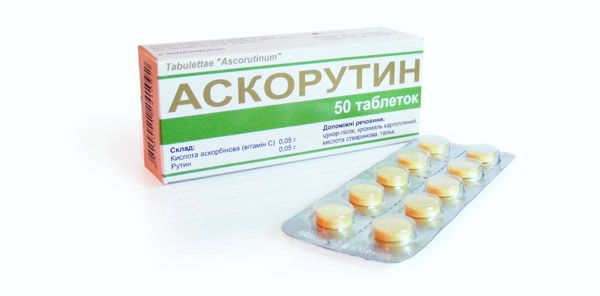
As a preventive measure, askorutin can be taken in a dose of one tablet twice a day. The duration of the treatment course is three to four weeks. The duration of treatment is prescribed by the doctor depending on the nature and severity of the disease.
Contraindications for taking this drug include individual intolerance of the patient's body to vitamin C or P, the first trimester of pregnancy, a history of diabetes mellitus, severe forms of urolithiasis, thrombophlebitis, gout, high blood clotting, and the age of the small patient under three years.
 [ 5 ]
[ 5 ]
Timolol for angioma
Beta-blockers are prescribed by a doctor when it is necessary to block beta-adrenergic receptors in the patient's body. If the pathology in question affects the eye area, then a drug such as timolol, which is one of the representatives of beta-blockers, can be used in the treatment of this disease.
The drops are applied in a dosage of one drop one or two times a day in the problem eye. Initially, the drug is used at a concentration of 0.25%. If the expected result is not observed, the concentration of the drug is increased to 0.5%.
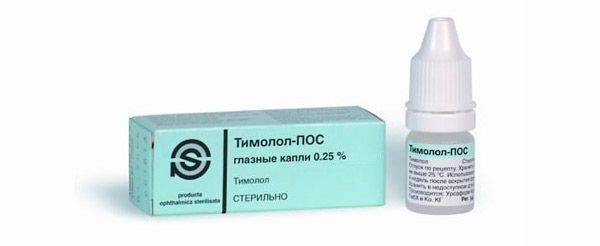
Contraindications to its use include:
- Individual intolerance to one or more components of the composition.
- History of bronchial asthma.
- Obstructive pathology of pulmonary tissue.
- Acute or chronic form of cardiac dysfunction.
- Cardiogenic shock.
- Decreased heart rate.
- Sick sinus syndrome.
- Corneal dystrophy.
- Tendency to allergic reactions.
- Breastfeeding period.
- The first years of a baby's life.
Troxevasin for angioma
A derivative of rutin, related to the means of therapy of chronic venous insufficiency - troxevasin. Angioprotective drug mainly affects capillaries and veins. It reduces the parameters of pores in the spaces of endothelial cells due to the restructuring of the fibrous matrix. Inhibits aggregation, shows anti-inflammatory characteristics and activates the deformability of erythrocytes.
This drug is approved for use in case of diagnosis of angioma.
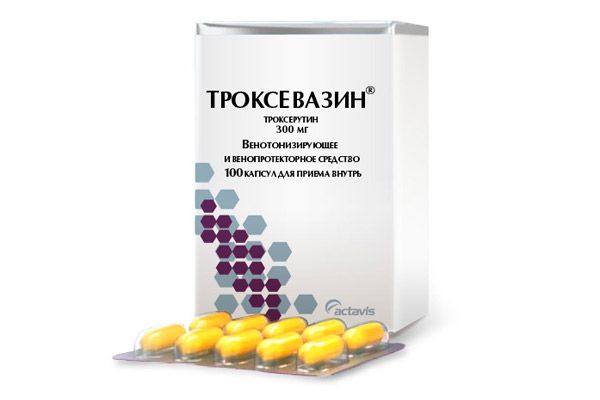
It is taken orally, two capsules before meals once or one capsule twice a day. If therapeutic effectiveness is not observed, the dosage can be increased, but all these prescriptions can only be made by a specialist. If the drug is prescribed in the form of a gel, it is applied and lightly rubbed into the sore spot twice a day: after waking up and before going to bed.
You just need to try to prevent Troxevasin gel from getting into your eyes, damaged areas of the skin, or mucous membranes.
Contraindications for taking this drug include individual intolerance of the patient's body to the components of the drug (including rutosides), the first trimester of pregnancy, ulcerative and erosive lesions of the gastric mucosa and duodenum, acute phase of chronic gastritis, severe renal failure.
Traditional treatment of angioma
The knowledge of our ancestors, including in the field of medicine, offers answers to many problems. But as the practice of treating angiomas shows, folk treatment of this pathology is only superficial. That is, these medicinal tinctures and ointments can control and support only the external side of the problem, but it is not possible to cure the disease completely.
Basic principles of caring for angiomas:
- Avoid mechanical, thermal and chemical damage to the skin area where the pathology is located. If the integrity of the skin is damaged, a secondary infection may join the disease in question.
- Protect from prolonged exposure to direct sunlight, especially sunburn.
We can offer several recipes of traditional medicine aimed at solving the problem that has arisen, but before that you should definitely contact a qualified specialist who will accurately diagnose and advise on the chosen method of treatment. At the same time, do not forget that the medicine used to treat angiomas can have a negative effect on the patient's body if there are other dermatological diseases on the skin surface of the body.
- Recipe No. 1 – using kombucha, which many housewives have in their kitchens today. The essence of the treatment method is to apply a piece of this organism to the affected area. It should be changed once a day, replacing it with a new piece of the mushroom that was previously in the water.
- Recipe #2 – First, dissolve a tablespoon of copper sulfate in one hundred milliliters of water. Soak the affected area with the resulting mixture. This procedure should be done daily for ten days. Then take a soda bath. The water in it should be hot. After the water procedure, apply an onion application to the problem area. It is easy to prepare: grate a peeled onion and keep it in a cool place for 12 hours. Soda baths and onion compresses should be done for the next ten days.
Nature is rich in flora, almost all of its representatives in one form or another are used in everyday life or in human treatment. Therefore, most recipes are still based on various herbal infusions or the preparation of medicine from one herb. Herbal treatment is the number one therapy for many diseases.
We are ready to offer a number of herbal preparations that can help in the fight against angiomas.
Recipe No. 1. Prepare a collection of the following herbs: pine buds - 100 g, rose hips - 100 g, yarrow stems and leaves - 100 g, chaga mushroom - 200 g, raw materials from wormwood - 5 g.
- Mix all ingredients and chop thoroughly.
- The resulting amount of the mixture must be poured with three liters of boiling water.
- Place the container on the fire and wait until it boils. From this point on, keep the broth on minimum heat for two hours.
- After this time, the saucepan must be removed from the heat, wrapped well and left to infuse for 24 hours in a warm place.
- Strain the liquid.
- After this, you need to add a glass (200 g) of aloe juice to the decoction, the leaves of which are at least three years old.
- Add a glass (250 g) of cognac and half a liter of honey. Mix all ingredients.
- Leave to stand for another four hours.
- Drink one tablespoon three times throughout the day immediately before main meals.
- The treatment schedule is as follows: a month of daily drug intake, a week of rest, a month of daily drug intake, a week of rest, a month of daily drug intake. That is, the total treatment time will take more than three months.
- Treatment frequency is once a year.
Recipe No. 2. Prepare a collection of the following herbs: St. John's wort - 30 g, coltsfoot - 45 g, cherry peduncle - 30 g, plantain - 60 g, calendula flowers - 30 g, yarrow - 15 g, celandine - 30 g, tansy - 15 g, cat's paw - 30 g, comfrey leaves - 15 g.
- Mix all ingredients and chop thoroughly.
- Take one tablespoon of the resulting mixture and combine it with 400 ml of boiling water.
- Place the container on the fire and wait until it boils. From this point on, keep the broth on minimum heat for five minutes.
- Set aside on the side and do not touch for an hour.
- Strain the broth.
- The resulting medicine should be taken three to four times a day. For maximum effectiveness, it is recommended to take it about twenty minutes before the expected meal.
- The duration of treatment is three weeks.
After completing a three-week treatment, you should take a two-week break. During this period, it would be a good idea to eat milk thistle powder three times a day along with food. This product should be chewed thoroughly.
Recipe #3. You can try wiping the affected areas with angiomas with a tincture of Kalanchoe leaves. To prepare this medicine, you should collect the leaves of the plant, wash them thoroughly and cut them into small pieces. Pour lukewarm boiled water over the resulting gruel. Place the mixture in a cool, darkened room for a week. Shake the medicine periodically for seven days. After the required time has passed, strain the mixture and moisten the angiomas with the liquid. It is advisable to wipe along the blood flow.
 [ 6 ], [ 7 ], [ 8 ], [ 9 ], [ 10 ]
[ 6 ], [ 7 ], [ 8 ], [ 9 ], [ 10 ]
Superchistotel
Today, such a medicinal plant as celandine is widely used in the treatment of many diseases. It is a frequent ingredient in numerous folk medicine recipes. Pharmaceutical companies have not ignored this unique plant either, and today they are ready to offer a wide range of medicines prepared on the basis of celandine. One of these is supercelandine, which is offered by pharmacies both in the form of a liquid placed in portioned bottles with darkened glass, and in the form of a liqueur.
This drug has a very specific smell, but its effectiveness in use compensates for many of the inconveniences associated with its use.
When treating with this drug, it is necessary to exercise certain caution. It should be remembered that celandine juice is a very strong toxin, and therefore a poison. Therefore, when applying the drug to the skin or taking it internally, it is necessary to strictly follow all the requirements of the instructions attached to the drug or the recommendations of the attending physician. When applying to the skin, there is a high risk of getting a burn or damaging the integrity of the skin. Therefore, the application of the drug is done exclusively pointwise, trying not to get on healthy tissue. Therefore, the consumption of the drug is minimal.
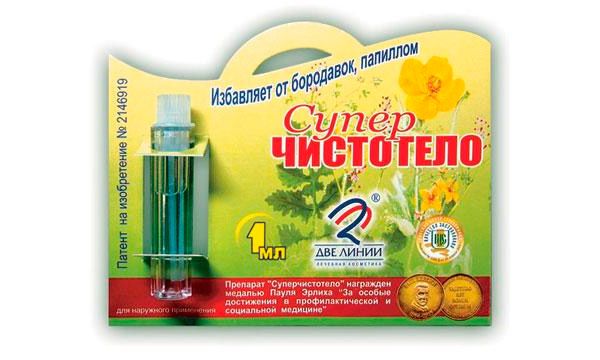
After applying the medicine to the angioma, you should wait until the medication dries completely. This treatment should be carried out once or twice a day. The duration of treatment is determined by the doctor, based on the condition of the neoplasm (until it is completely burned out) and the general well-being of the patient.
Lekker superchistotel has all the same characteristics as the liquid described above, with the only difference being that it is presented in the form of a felt-tip pen, produced in a volume of 3 ml. Its advantage over the liquid in a bottle is its convenience. This form of the drug makes it possible to apply the medicine quite accurately to the affected area of the body, preventing it from getting on healthy tissue.
At the same time, its small volumes make it possible to place them even in a small bag, allowing you to take them with you on the road or to work. Thanks to the developed and implemented design of the felt-tip pen itself, the likelihood of spilling liquid is excluded.
Superchistotel is a highly effective antiviral and exfoliating agent. Thanks to the dye introduced into its composition, the application process can be easily controlled.
Homeopathy
This section of traditional medicine is based on the principles of carefully developed compositions of drugs designed to stop a particular disease. Homeopathy in the treatment of dermatological diseases involves not only the elimination of pathological symptoms, but also the impact on the cause of the pathology. Homeopathic medicines, for the most part, are drugs with a complex effect on the patient's body. Oral administration of the drug allows you to influence the function of all internal organs, including the components of the skin.
In light of the problem discussed in this article, it is recommended to use drugs developed and produced on the basis of sulfur, lime sulfur and sodium sulfate.
You can call such a medicine as "Loma Lux acne". This pharmacological substance was developed by American pharmacists studying dermatological diseases. This drug has already proven its effectiveness in the treatment of acne and agniomas. But it should be noted that, despite its naturalness, and perhaps because of this, this drug is not perceived by every organism. Therefore, the approach to its appointment should be strictly individual. At the same time, the contraindications of this drug, in addition to the possibility of developing an allergy to the component composition, include the patient's age. "Loma Lux acne" is not prescribed to children under six years of age.
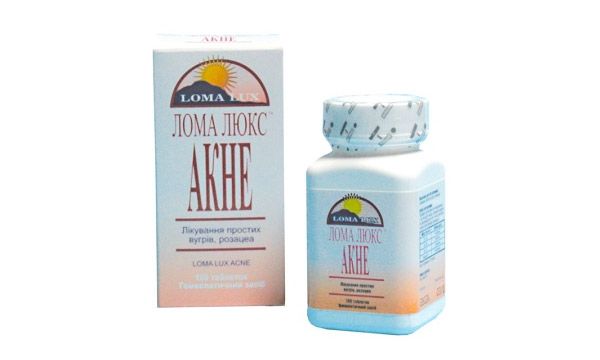
You should not take homeopathic remedies thoughtlessly, ignoring their side effects. Therefore, if you want to treat the problem this way, you should first consult with your doctor. This may be a dermatologist, but a consultation with a homeopathic specialist is also desirable.
When diagnosing angioma, homeopathic preparations such as acidum fluoricum, condurango cortex, calcarea fluorica, lycopodium, pulsatilla, radium bromine, solanum nigrum and a number of other medicines also show good effectiveness.
But when taking homeopathic medicines, you need to carefully monitor your health. If your condition worsens, or any negative side symptoms appear, you need to stop taking the medicine and consult a specialist. Perhaps he will adjust the dosage or replace the medicine.
Having carefully read this article and having the disease under consideration in the diagnosis, it is necessary to make the only correct conclusion that home self-treatment, especially the removal of angiomas, is absolutely unacceptable. Making a diagnosis, prescribing a path and methods for solving the problem, removing the neoplasm is the prerogative of only a highly qualified specialist. This is how you can get the expected effect from the treatment without causing significant damage to your body, including secondary infection. Be more attentive to yourself and do not ignore the advice and help of a specialist

